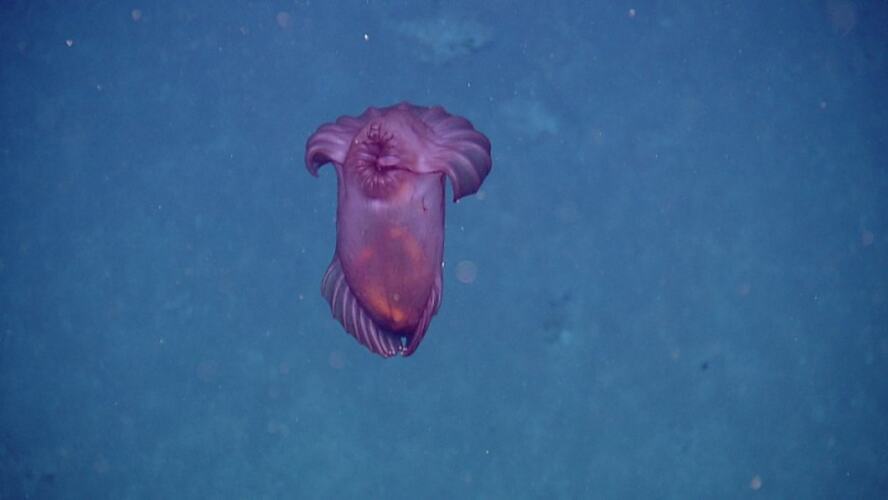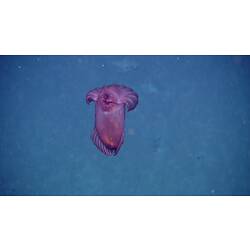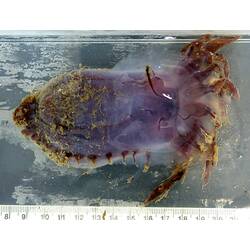General Description
Body is fragile, gelatinous and bulbous with a convex dorsal surface, flattened ventrally; ventral mouth, dorsal anus; pink, brown-red to purple body; ~20 leaf-like bifurcated tentacles; 12 webbed podia are fused to form a very broad anterior cowl and 10-15 form the smaller lateral posterior brim, creating fin-like structures for swimming; ossicles, internal respiratory trees and calcareous ring are all absent; up to 25cms.
Biology
Enypniastes exima is not shaped like a 'typical' sea cucumber, the gelatinous, bulbous animal instead sits vertically in the water, topped by an umbrella-like brim, which helps it to swim with a rowing-like motion through the deep sea. The only species in its genus, it is also the only species from the Family Pelagothuriidae known to occur in Australian waters. Its fragile body is usually damaged during collection, so we are only starting to gain a better understanding of the biology of this species from recent ROV (Remotely Operated underwater Vehicle) footage.
The genus name Enypniastes means 'dreamer' though this species is known by various common names including the less favourable 'headless chicken monster'. Its 'Spanish dancer' or 'swimming sea cucumber' monikers may be better names considering its graceful swimming motion. Being gelatinous and full of water makes this species neutrally buoyant, so it can use its tentacles to pull itself into the current and drift along. The webbed anterior cowl is also used to propel it through the water in a rowing motion while the posterior lateral veils are used as stabilisation fins or brakes when necessary.
Typically pink, purple or reddish brown, Enypniastes exima is also somewhat translucent, making it easy to see the coiled gut with its sediment ballast through the body wall. A bentho-pelagic species, it is usually seen floating above silty/ sandy seafloors, but descends often to feed briefly on 'marine snow', organic particles which have floated down from above and now sit on top of the sediment. It has been observed to 'poop' before take-off to reduce excess weight, leaving behind a cleaned, aerated cast of sediment. This important ecological process of turning ocean sediment, similar to an earthworm on land, is known as 'bioturbation'.
Like some other deep-sea sea cucumbers, this species has been observed to display bioluminescence, triggered mechanically by granular bodies in the body wall following physical contact. The reaction highlights pieces of its fragile skin/body wall that can be flaked off, distracting predators and lighting up the surrounding water allowing for escape. This skin with its bioluminescent properties can then be regenerated by the animal.
Enypniastes exima was first described from specimens collected at just over 2000 m in the South Pacific Ocean during the historic voyage of the H.M.S. Challenger 1873-1876, and has since been found in many regions world-wide, including the Southern Ocean near Eastern Antarctic where it was observed in October 2018. On the Sampling the Abyss Sampling the Abyss expedition this species was found in the Central Eastern Marine park (from 30 kms east of Coffs Harbour, NSW) at a depth of 1225 m.
Distribution
Worldwide. In Australia currently recorded from deep sea off Western Australia, South Australia, New South Wales, and Tasmania.
Habitat
Bathyal to hadal depths (500 to 7000+ m)
More Information
-
Animal Type
-
Animal SubType
-
Fast Fact
Known to poo before take off!
-
Brief Id
Gelatenous, bulbous, pink/brown-red to dark purple body with webbed fin-like structures anterior and posterior for swimming.
-
Maximum Size
25 cm
-
Habitats
-
Diet
Organic matter
-
Endemicity
-
Taxon Name
-
Scientific Author
Théel, 1882
-
Common Name
Swimming sea cucumber
-
Other Names
Headless chicken monster , Sea Cucumber , Spanish dancer
-
Phylum
-
Class
-
Order
-
Family
-
Genus
-
Species Name
eximia




